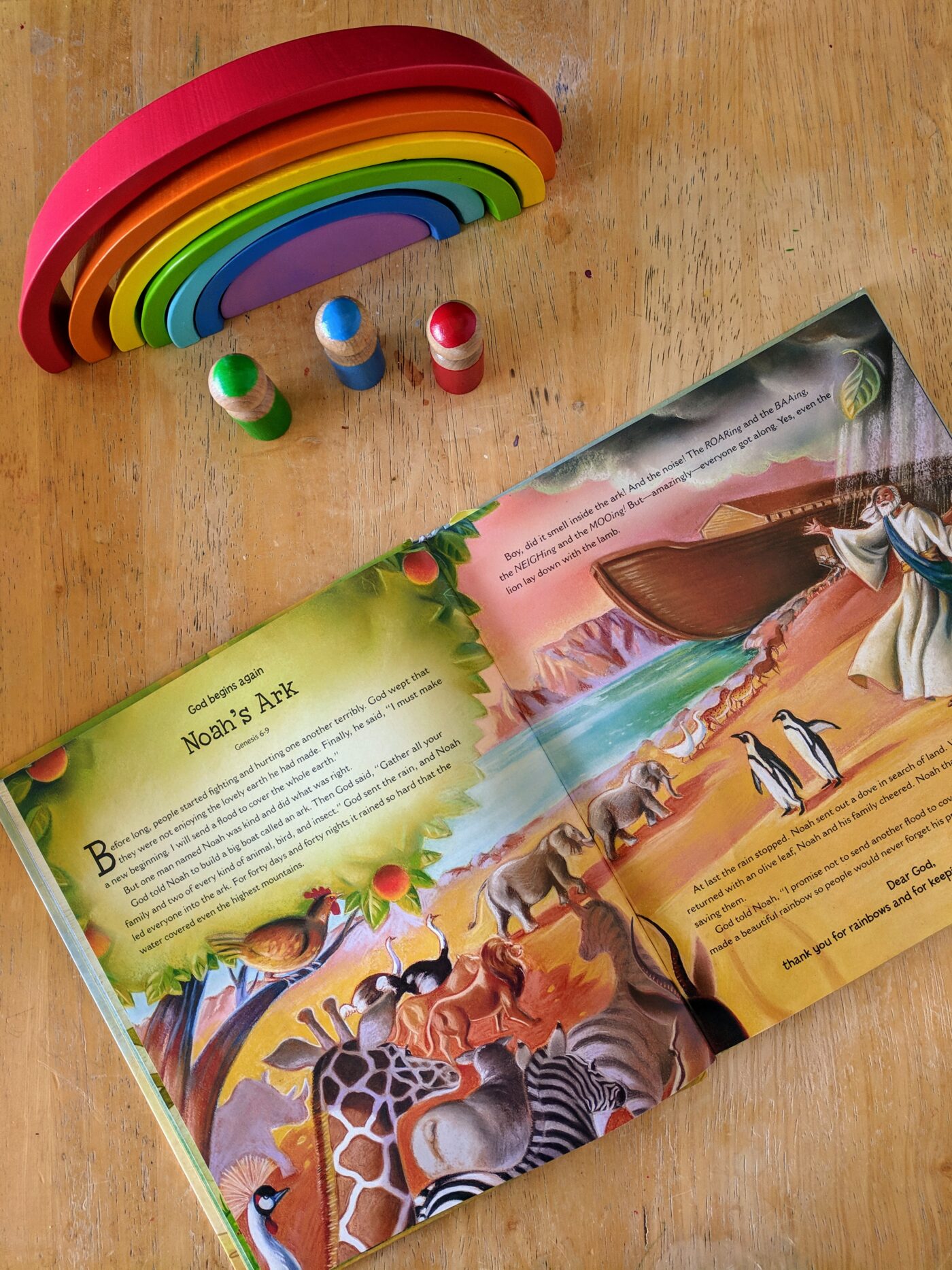There is just something special about story Bibles. Colorful illustrations, beloved stories, sometimes sweet rhymes, and intentional storytelling for littles, these books are gifts to those who serve children at church and home. While they cannot replace the full-text Bible, story Bibles are a useful tool for helping younger children to learn the stories of our faith and the God who loves them in a developmentally appropriate way.
Why Story Bibles Can Work
Why are story Bibles so powerful with children? Because God designed us for story, and children, especially, learn through narratives. While the full-text Bible is full of stories, most translations are not written at a developmentally appropriate reading level for children, and that is okay! It doesn’t mean we don’t continue to use the Bible; it means we supplement full-text Bible stories with more developmentally appropriate tools to help children understand and fall in love with the stories, meta-narrative, and God of the Bible. That is done with the hope and prayer that as they grow and mature, they will become confident in reading and familiar with God’s Word.
Story Bibles combine God’s stories with developmentally appropriate writing and engaging pictures to help kids’ minds activate in powerful ways for learning. When psychologists from Emory University studied parents teaching children science facts through narrative, they “found that children had higher recall of the story content, even though caregivers emphasized the science content through their highlighted extratextual talk.”1 So, even if we are using stories to point to some other theological lesson, the story will most likely be the part that children remember.
Citation
1. Hilary E. Miller-Goldwater, Melanie H. Hanft, Alissa G. Miller, and Patricia J. Bauer. 2024. “Young Children’s Science Learning from Narrative Books: The Role of Text Cohesion and Caregivers’ Extratextual Talk.” Journal of Cognition and Development 25 (3): 323–49. doi:10.1080/15248372.2023.2267229.
5 Practical Strategies for Using Story Bibles Effectively
As we share story Bibles with children, we want to be intentional to stay faithful to God’s Word and maximize our efforts in sharing his love. Here are five practical strategies for using story Bibles effectively:
Utilize Interactive Reading Techniques
First, practice interactive reading strategies such as:
- Adaptive Tones, Volume Variations, and Character Voices – The design of many story Bibles brings this out more easily for adult readers than a full-text Bible.
- Pause-and-predict moments– Using intentionally placed pauses to ask children what they think may happen next.
- Action movements – Invite children to stomp as Goliath might have or rock in a boat on the waves of a storm. Big and little movements enhance learning.
- Sound Effects and Audience Participation – What did the wind sound like? Can you make your room sound like the ark might have sounded?
Invite Visual Engagement
The art is one of my favorite things about story Bibles. The illustrations can be used before, during, and after reading. Invite children to share their observations of the illustrations. What do they think the story will be about? Who are the characters they can identify? What do the pictures tell you about the culture of the Bible? Can they retell the story based on the pictures?
Welcome Questions and Conversations
Children are full of questions and curiosities. When reading story Bibles, we can include time for those questions and curiosities. Use open-ended questions and wonder together, before, during, and after the story. Often, story Bible stories are short, leaving room for us to listen to children’s thoughts, observations, and wonderings.
Learn to welcome interruptions in the story as ministry moments. Kids’ questions don’t usually wait until the story is over, and that is okay. If you can welcome the moments with grace and attention, it can help the children feel heard and valued.
Explore Through Play
Kids make meaning of what they are learning through play. Add some simple, open-ended toys for children to play with after the story. You can even use them as props with the story.
Blocks, peg dolls, animals, and art supplies are all easy to adapt to many different stories.
Play is best when it is child-led and chosen. Check out this article for more.
Connect to Scripture
Our goal with story Bibles is not to replace full-text Bibles, but to supplement them. A few things you can do to help connect to Scripture are:
- Show kids where the Bible story is found in a Bible
- Begin with an overview of where the story falls in the metanarrative of Scripture
- Depending on the story, you may want to read both
- Use the story Bible on the second time through the story if you spend more than one week on a story
- Discuss what parts of the story are in the Bible and which parts are from the story Bible author’s imagination and historical context.
Review the 5 Tips
1. Utilize Interactive Reading Techniques
2. Invite Visual Engagement
3. Welcome Questions and Conversations
4. Explore Through Play
5. Connect to Scripture
Conclusion
There are many ways you can supplement Scripture with story Bibles. Even within a collection of story Bibles, some may be better for different ages or purposes. You can see some of our favorite story Bibles by age here.
We encourage you to find a few that you love and rotate them into your Bible story time. You and the children you serve may fall in love with the stories and pictures, and in turn fall deeper in love with the God behind the stories.
-
Citation
1. Hilary E. Miller-Goldwater, Melanie H. Hanft, Alissa G. Miller, and Patricia J. Bauer. 2024. “Young Children’s Science Learning from Narrative Books: The Role of Text Cohesion and Caregivers’ Extratextual Talk.” Journal of Cognition and Development 25 (3): 323–49. doi:10.1080/15248372.2023.2267229.
